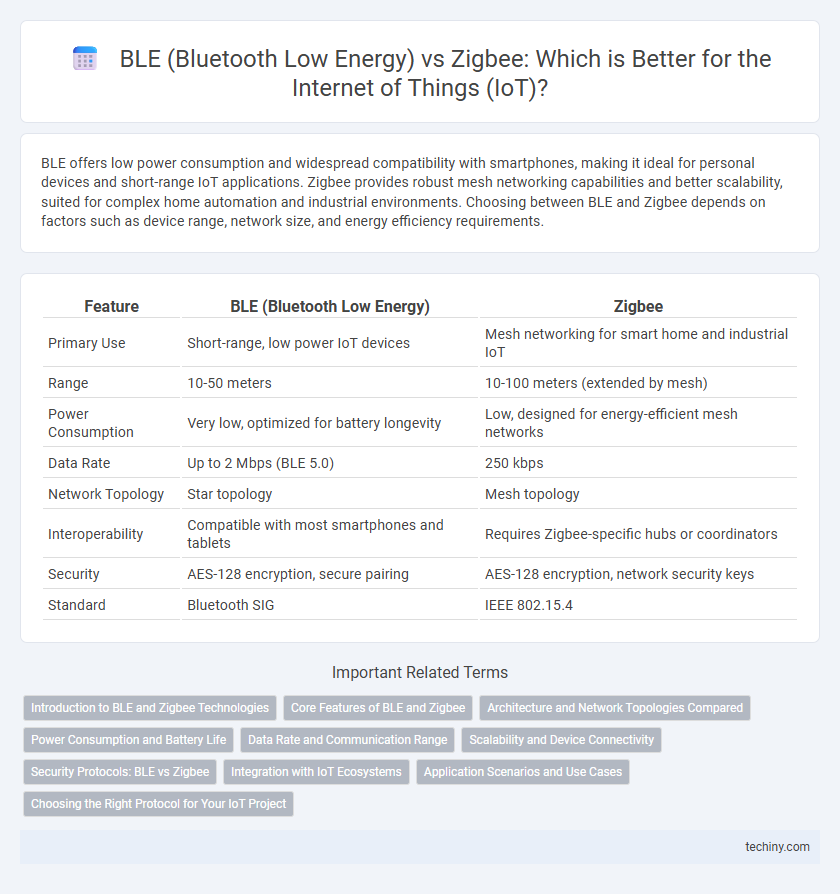BLE offers low power consumption and widespread compatibility with smartphones, making it ideal for personal devices and short-range IoT applications. Zigbee provides robust mesh networking capabilities and better scalability, suited for complex home automation and industrial environments. Choosing between BLE and Zigbee depends on factors such as device range, network size, and energy efficiency requirements.
Table of Comparison
| Feature | BLE (Bluetooth Low Energy) | Zigbee |
|---|---|---|
| Primary Use | Short-range, low power IoT devices | Mesh networking for smart home and industrial IoT |
| Range | 10-50 meters | 10-100 meters (extended by mesh) |
| Power Consumption | Very low, optimized for battery longevity | Low, designed for energy-efficient mesh networks |
| Data Rate | Up to 2 Mbps (BLE 5.0) | 250 kbps |
| Network Topology | Star topology | Mesh topology |
| Interoperability | Compatible with most smartphones and tablets | Requires Zigbee-specific hubs or coordinators |
| Security | AES-128 encryption, secure pairing | AES-128 encryption, network security keys |
| Standard | Bluetooth SIG | IEEE 802.15.4 |
Introduction to BLE and Zigbee Technologies
Bluetooth Low Energy (BLE) operates in the 2.4 GHz ISM band, providing low power consumption and short-range wireless communication ideal for personal area networks and IoT devices requiring frequent data transmission. Zigbee, also using the 2.4 GHz frequency, supports mesh networking with low data rates and extended range, making it suitable for home automation, industrial control, and sensor networks requiring robust and scalable connectivity. Both BLE and Zigbee emphasize low energy usage but differ in network topology and application focus within the IoT ecosystem.
Core Features of BLE and Zigbee
BLE (Bluetooth Low Energy) offers low power consumption, fast connection setup, and widespread compatibility with smartphones and tablets, making it ideal for personal area networks and wearable devices. Zigbee features mesh networking capabilities, extended range, and robust security protocols, which are essential for smart home automation and industrial IoT applications. Both protocols support low data rate communication, but Zigbee excels in network scalability and device density, while BLE prioritizes energy efficiency and interoperability.
Architecture and Network Topologies Compared
BLE (Bluetooth Low Energy) employs a star topology where central devices communicate directly with peripheral nodes, optimizing low power consumption in short-range applications. Zigbee supports mesh, star, and tree topologies, enabling scalable, self-healing networks ideal for extensive IoT deployments requiring multi-hop communication. The architectural flexibility of Zigbee allows robust device interconnectivity, while BLE prioritizes minimal latency and energy efficiency in simpler network structures.
Power Consumption and Battery Life
Bluetooth Low Energy (BLE) demonstrates significantly lower power consumption compared to Zigbee, making it ideal for battery-powered IoT devices requiring extended operation times. BLE typically supports battery life ranging from months to several years depending on usage patterns, whereas Zigbee devices often have higher energy demands due to their mesh networking capabilities. Optimizing power management in BLE enables minimal energy usage during idle states, directly extending battery longevity in IoT applications.
Data Rate and Communication Range
Bluetooth Low Energy (BLE) offers data rates up to 2 Mbps, making it suitable for applications requiring faster transmission speeds over short distances, typically around 10 to 30 meters. Zigbee supports lower data rates, generally up to 250 kbps, but excels in communication range with mesh networking capabilities extending coverage up to 100 meters or more in optimal conditions. BLE is often favored for quick, point-to-point connections, while Zigbee is preferred for low-power devices needing extended network coverage and reliable multi-hop communication in IoT deployments.
Scalability and Device Connectivity
BLE supports scalable device connectivity with efficient energy consumption, ideal for personal area networks and smaller device ecosystems. Zigbee excels in large-scale IoT deployments, offering robust mesh networking that facilitates thousands of devices communicating seamlessly over wider areas. The choice between BLE and Zigbee depends on network size requirements, with Zigbee being more suitable for extensive scalability and BLE favoring simpler, low-power connections.
Security Protocols: BLE vs Zigbee
Bluetooth Low Energy (BLE) employs AES-128 encryption with the Security Manager Protocol (SMP) for pairing and key distribution, ensuring device authentication and data confidentiality. Zigbee utilizes the IEEE 802.15.4 standard's AES-128 encryption combined with network-layer security mechanisms, including frame counters and key establishment protocols, to prevent replay attacks and unauthorized access. BLE's security is optimized for short-range device connections, while Zigbee offers robust, scalable security suited for mesh network architectures in Internet of Things (IoT) deployments.
Integration with IoT Ecosystems
BLE integrates seamlessly with consumer-centric IoT ecosystems like smartphones and wearables, offering straightforward connectivity and low power consumption for personal devices. Zigbee excels in building automation and industrial IoT environments, supporting mesh networking for extended range and reliable device communication. Both protocols enhance IoT integration by catering to different use cases--BLE for close-range, low-energy applications and Zigbee for scalable, robust network infrastructures.
Application Scenarios and Use Cases
BLE (Bluetooth Low Energy) excels in short-range, low-power applications such as wearable devices, fitness trackers, and smartphone peripherals, thanks to its widespread smartphone compatibility and ease of integration. Zigbee is better suited for large-scale home automation and industrial IoT networks where mesh networking enhances reliability and range, supporting applications like smart lighting, energy management, and sensor networks. The choice between BLE and Zigbee depends heavily on factors like network size, power consumption needs, data throughput, and device interoperability requirements.
Choosing the Right Protocol for Your IoT Project
Bluetooth Low Energy (BLE) offers widespread compatibility with smartphones and low power consumption, making it ideal for short-range IoT applications like fitness trackers and smart home devices. Zigbee excels in mesh networking capabilities, enabling reliable long-range communication and scalability for complex sensor networks and industrial automation. Evaluating factors such as device density, range requirements, power consumption, and interoperability ensures selecting the most efficient protocol for your specific IoT project goals.
BLE (Bluetooth Low Energy) vs Zigbee Infographic

 techiny.com
techiny.com